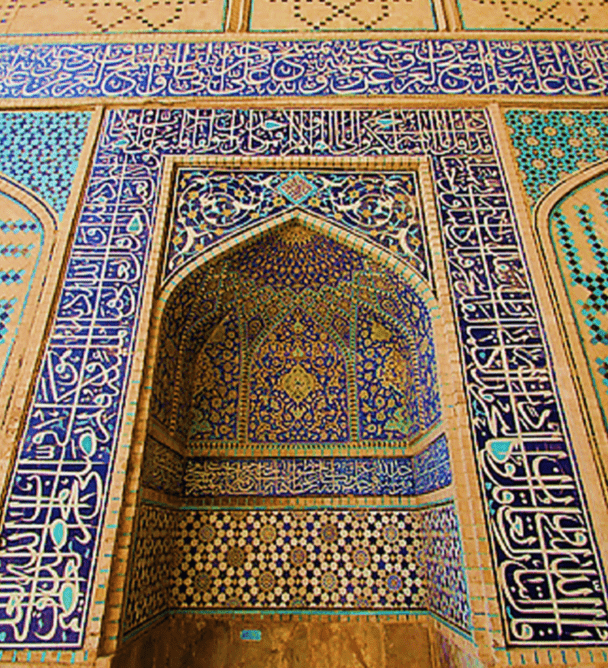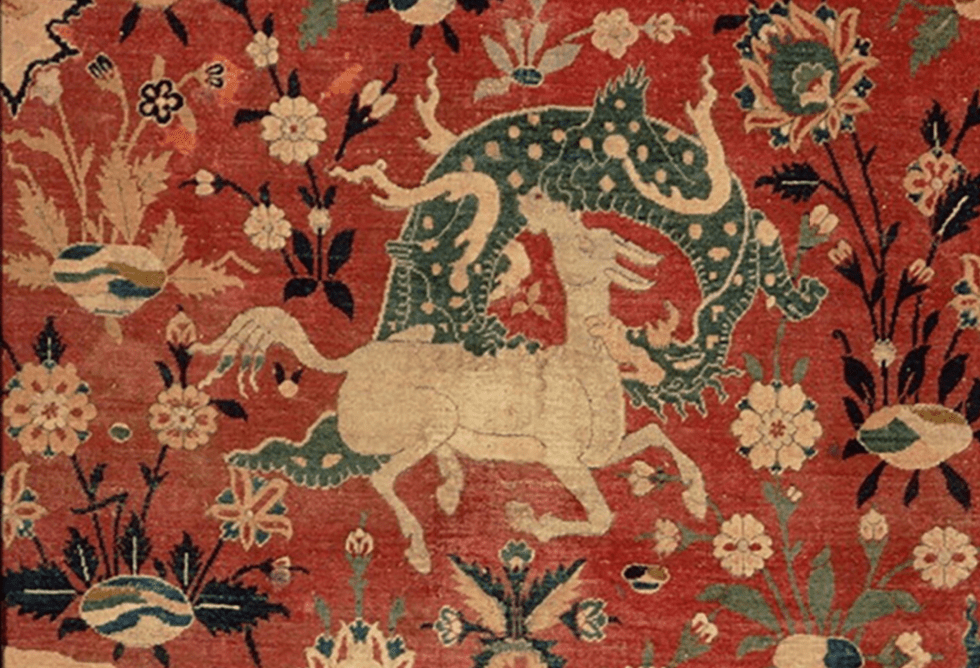Coping with Culture Shock through Handicrafts: The Persian Rug in the Ex-Patriate American Home
Behin Forghanifar
I was floating between the senses of fear and excitement as the plane slowly landed at JFK airport in August 2017. While I was glued to the plane window on my flight from Tehran, I remembered my Iranian friends in the United States warned me that I might feel culture shock and homesick, despite the fact that Tehran and New York City, as big cities, have many similarities. They were right. Living in an unfamiliar culture is disorienting. This confusion can challenge a person’s cultural and national identity, making the transition a struggle and inducing the feeling of culture shock.
Iranians make up a significant part of the population among many other immigrants to the United States.1 This is in large part due to events such as the 1979 Islamic revolution, the war with Iraq in the 1980s, and other political changes that occurred over the last 30 years. I was joining their number—not because of political changes, but to pursue a master’s degree in Design Studies at Parsons School of Design.
Being curious about Iranians’ adaptations to American culture, I joined some Persian communities and spent time with several families living in New York City, specifically in Brooklyn and Manhattan. I realized many Iranians use cultural stimuli such as handicrafts to feel more at home in a new country, including myself. This is one strategy we use to deal with culture shock and the sense of displacement it engenders. There are some who may advise expatriates to immerse themselves into their new culture as an effective means to cure their homesickness, but this is not what seems to happen in Iranian immigrant communities. We want to stay attached to our native identity, and in my research, I found that the possession of Iranian objects in the new home reinforces a sense of identity. Among the many kinds of handicrafts that expatriates could choose from, rugs may be the most popular. Iranians tend to have at least one in their homes, even if it is only a small one. The Persian carpet (or rug, used interchangeably) is a symbol of an Iranian family lifestyle, with its design representative of their cultural beliefs.
To investigate the association of handicrafts with Iranians’ acculturation, we need to first look at the overall scheme of culture shock. According to Paul Pedersen, culture shock is divided into five stages; the honeymoon, disintegration, reintegration, autonomy, and interdependence (or adaptation).2 Each stage can be long-standing or appearing only under certain conditions. These five stages start with the excitement and enthusiasm (honeymoon) about the new culture as with my own experience flying into New York.3 The differences I noticed in this phase were intriguing to me, and I felt both stimulated and curious about almost everything I came into contact with. Then comes the experience of being overwhelmed by one’s environment (disintegration) and the feeling of inadequacy proceeds to the reintegration stage through which the immigrant rejects the second culture completely.4 I also experienced this when one of my friends started to develop some prejudices toward the new culture after moving to New York City and living here for four months. He was frustrated and kept idealizing life back home. During the fourth stage, the immigrant will experience the increasing ability of seeing good and bad things in both cultures, which leads to a balanced interpretation of them (autonomy).5 This results in the adjustment or adaptation phase, through which the person becomes fluently comfortable in both cultures. The immigrant, theoretically, is fully able to accept cultural similarities and differences and is thus capable of giving meaning to situations.6 There is controversy, however, as to whether the immigrant can truly reach this stage or if it is actually unachievable in its idealism. From research conducted at University of Technology Sydney focusing specifically on the effects of immigration on Iranian communities, we learn it is not uncommon for immigrants who experience culture shock to feel social and cultural isolation and deal with consequences such as depression and anxiety.7 Since the American culture is significantly different from the Iranian culture, Iranians may face more difficulties adjusting to the culture in the United States, as Shireen Ghaffarian, an Iranian psychologist, states:
Iran has a history of monarchy; America is a democracy. Iran has a Zoroastrian-Muslim heritage; America has a Judeo-Christian heritage. Iran is old; America is young. Iran, for the most part, is a pre-industrial nation; America is an industrial nation… The majority of Iranians are members of extended families; the majority of Americans are member of nuclear families.8
Given the extreme nature of the differences observed by Ghaffarian, we need to examine why handicrafts are able to serve as a source of comfort and stability. The compound word handicraft consists of two words—hand and craft. Craft is a way of doing something by thinking through practices. Craft is a process rather than a fixed set of things that exists in association with materials and skills. According to craft historian Glenn Adamson, “Craft is not a movement or field, but rather a set of concerns that is implicated across many types of cultural production.”9 So crafting things by hand—and owning handcrafted things—can engage with cultural practices and offer what is perceived to be a form of expression representing a culture, tradition, and the heritage of a country.
The Persian Rug (Carpet)
For many centuries, Persian art has been acknowledged particularly for its rug- or carpet-making traditions. In Persia (Iran only became this ancient land’s name in 1935.) carpet-making as an independent craft activity was considered to have developed between the 13th and 15th centuries CE, although according to recent discoveries, the origin of a handmade pile of Persian carpets dates back to 700 CE.10 The versatility of Persian carpets means they are adaptable for many uses as utilitarian, decorative, and religious objects. The use of the carpet as a household element has been widespread since the end of the 19th century in Iran. Hand-knotted rugs were and continue to be used in the homes of the upper classes and infrequently among the middle and lower classes.11 For Iranians, the hand-knotted carpet is of distinct significance. Since weaving is one of the very first craft activities by nomads in ancient Persia, a handmade rug is a piece of cultural heritage that evokes socioeconomic, cultural, and political developments in Iran from the premodern to the modern era. Second, because of its elaborate and finely knotted silk composition (compared to felt and machine-spun carpets)12 it is mainly used in special occasions, ceremonies, and religious rituals.
Looking at the carpet through the lens of design, Arthur Upham Pope, an American expert on Iranian handicrafts, describes the Persian carpet as one of the most important crafts in Iran because it correlates with many other Persian arts like painting, miniatures, architecture, ceramics, and poetry while also serving as a representation of basic Islamic beliefs.13
Beginning around 650 CE, Islamic arts and crafts in Persia integrated religious beliefs to preserve some pre-Islamic myths—such as the history and ancient traditions of Persia. For example, reliefs of the Apadana in Persepolis (500 BCE) were made of finely crafted stones which represent a history of Achaemenes through ancient symbols such as the lotus flower, lion, and bull.14 (Fig. 1) The repetition of lotus flowers, known as the Iranian national symbol, signifies eternity, prosperity, rebirth, and maturity. The lion and bull, which are central in the relief, are two Persian mythical symbols. One interpretation of the battle of the lion and bull is the defeat of winter by the spring equinox. Though the history of Persian craftwork has since moved on to more geometric, religious content,15 Iranians still recognize these forms in the stories they continue to tell today, embodied in Persian craftwork.

Figure 1. Part of a bas-relief of a lion attacking a bull in Persepolis (Takht-e-Jamshid). Shiraz, Iran. Source: http://www.irlotus.ir/gallery/shiraz.html.
Considering the tiles in the Jameh Mosque in Isfahan, the calligraphy of passages from the Quran is an important decorative aspect. The tiles depict symmetrical geometric patterns, which are mentioned in the Quran as the sign of unity and harmony in the universe created by God. The green, yellow, and turquoise colors besides arabesque motifs recalls spirituality, faith, and Islamic heaven. (Fig. 2) For Iranians, handicraft could be religious or non-religious, figurative or non-figurative, or a combination of all. The patterns, motifs, and colors, which continue to be the main motifs in Iranian handicrafts today, not only indicate the spiritual or religious beliefs of its maker, but they also embody what today’s Iranians recognize as intellectual and sacred values of life such as insight, spirituality, generosity, fidelity, and sublimity.

Figure 2. Jameh Mosque of Isfahan. Reibai, Isfahan, Iran, 2011. Source: http://islamic-arts. org/2012/jameh-mosque-of-isfahan/.
In the Persian rug specifically, the organizations of content convey a narrative using dense patterns, rich and bold colors (such as red), and medallion motifs. Stories of the Persian rug and its symbolism have been passed down from one generation to the next. According to Ali Esmaili, owner of Esmaili Rugs and Antiques in Dallas, Texas: “The symbols in the Persian carpet often were believed to protect the rug’s owner from misfortune. The symbolic narratives in Persian rugs may represent historical monuments, scenes from daily life, Islamic buildings, weeping willows, and religious imagery such as the Tree of Life or the Garden of Paradise.”16 Some recurring symbols in Persian rugs, relating to pre-Islamic craft include Gol (flowers such as the peony, lotus, and tulip, which symbolize prosperity, rebirth, youth, and purity); Morgh (birds such as the eagle, peacock, and phoenix, which symbolize good fortune, immortality, glory, and the heaven); and other animals like gazelles, lions, and fish, which are used to signify power, bravery, and escape from danger. (Fig. 3)

Figure 3. Silk carpet. Silk carpet. Kashan, Iran, second half 16th century. Courtesy of the Metropolitan Museum of Art. Source: https://www.metmuseum.org/art/collection/search/446642.
One of the conspicuous reasons why the carpet, among other handicrafts, is remarkable to Iranians is the way the carpet symbolizes and structures the space of family life. Even today, carpets are the main floor covering in the arrangement of typical Iranian interiors. Its bright colors bring life and warmth to the room. Because sofas were not common within middle- or working-class homes, people used rugs for many collective family activities. Persian carpets often have borders that serve as frames, drawing attention to the center of the carpet, and this offers a comforting symmetry and sense of balance to the room. Echoing the rug’s harmony and balance, family members usually sit on the borders all around the carpet and dedicate the center to collective activities such as eating or dancing. In this way, carpets function as a memory device.
However, today, since many Iranian houses have a transitional interior design, in the mixing of modern and traditional furnishing, the Persian carpet is used in configuration with modern furniture such as sofas. A Persian rug is used differently in New York and Iran. In a home in Iran, the most precious carpet is designated to the guest room, and while there is some modern furniture, it stays clear from the middle of the carpet to attract attention to the carpet’s center. By arranging the sofas in symmetry around the carpet, the room achieves a sense of balance. (Fig. 4, Fig. 5) Since some Iranians still sit on the carpet occasionally, it is customary to change or take off their shoes after entering the house. The action required by the carpet sends signals to the guest to perform this way in relation to the carpet as a way of respecting the host’s religious beliefs—as the carpet can double as a place for Muslims to pray.

Figure 4. Handmade Persian carpet, silk.j@farsh_co), 2019. Courtesy of Instagram. Source: https://www.pictame.com/media/ 1977424038892605275_9976301589#media-1.

Figure 5. Handmade Persian Carpet for an Iranian Home. Unknown photographer. Courtesy of Nikazin Furniture Group. Source: http://www.nikazin.com/fa/usefultips/usefultips500/usefultips5002/setsofarug
On the other hand, the majority of Iranians in New York don’t live in big houses, nor can they afford to buy handmade carpets in the US. Therefore, to feel at home, Iranian immigrants either bring a small rug with them when they move to the States, or they buy one here, which is usually machine-made but will feature a similar pattern and colors to the handmade one they left back in Iran. Living with roommates and in small rooms, Iranians students, who constitute a large group of immigrants, find alternative ways to incorporate the Persian rug (and the value it embodies) into their limited spaces.
For example, when I moved to the United States in 2017, I brought a small handmade rug because I had baggage restrictions, and I wasn’t sure about the place I would be settling in. Using that small rug in my room and sitting on it has helped me remember the sense of warmth and familial intimacy I had in my home in Tehran. That feeling motivated me to bring another decorative miniature rug the next year, which I hung on my wall. The presence of this decorative piece (even if small) in my room signifies to me the motifs and patterns in Iranian arts and crafts, and I associate these cultural signs to my identity. (Fig. 6)

Figure 6. Small Persian decorative rugs in the author’s room. Behin Forghanifar, Queens, New York, 2019. Courtesy of Behin Forghanifar.
For Iranians, either inside or outside the country, handicrafts (in general) and carpets (in particular) are salient objects for a shared remembering of their history, religious beliefs, traditional values, and cultural heritage. By activating their cultural memories with carpets, they preserve their national identity against the dominant tendency of cultural oblivion within a new culture. Iranians have made a considerable effort to modernize to avoid the feeling of isolation from the constant challenges Iran had with Western countries—specifically the United States—after the 1979 Islamic Revolution. As a result, they gained a vast understanding of Western cultures while still preserving their ancient Persian culture. This combination is evident in their fashion trends, social media use, and lifestyle. Iranians have always situated themselves between global modernity and Iranian/Islamic traditions. So, after immigrating to the United States, they unconsciously find themselves leaning into American culture.
Due to the significant cultural differences between Iran and Western countries, adopting at least one strategy of cultural adjustment, such as the carpet, may be crucial in coping with culture shock for Iranians who immigrated to the United States. It may be even more vital for those who settle in New York, where there is a smaller community of Iranians, compared to states like California, where a higher concentration of Iranian immigrants live. As families move to a new location, or as children move before the older generation, familial relations can become volatile. Since Iranians have more of an extended-family oriented culture than others, such as the nuclear-family focus of American culture, the presence of crafts—specifically a Persian carpet—at home helps this community adjust to new cultures with less anxiety about losing their original culture.
1 Though no verified number exists, the US Census Bureau reported in 2011 that the estimated number of people with Iranian ancestors in the United States was 470,341 (2011 American Community Survey Ancestry, https://archive.org/details/2011AmericanCommunitySurveyAncestry). Though due to the issues with self-identification, the number of Iranian immigrants, including later generations of Iranian-Americans is closer to around 1 million, last reported in 2009 (Azadeh Ansari, “Iranian-Americans cast ballots on Iran’s future,” CNN, June 16, 2009, http://www.cnn.com/2009/US/06/12/iran.elections.voting/).↵
2 Paul Pederson, The Five Stages of Culture Shock: Critical Incidents Around the World (London: Greenwood Press, 1995), 3.↵
3 Ibid, 26.↵
4 Ibid,79.↵
5 Ibid, 201.↵
6 Ibid, 245.↵
7 Sara Shishehgar, Leila Gholizadeh, Michelle DiGiacomo, Patricia M. Davidson, “The Impact of Migration on the Health Status of Iranians: An Integrative Literature Review,” BMC International Health and Human Rights 15, no. 20 (2015): 2.↵
8 Shireen Ghaffarian,” The Acculturation of Iranian Immigrants in the United States and the Implications for Mental Health” in The Journal of Social Psychology, 138, no. 5 (1998): 645.↵
9 Glenn Adamson, The Craft Reader, (Oxford, Berg Publication, 2009), 3.↵
10Leonard M. Helfgott, Ties That Bind: A Social History of the Iranian Carpet, (Washington and London: Smithsonian Institution Press, 1994), 26.↵
11 Helfgott, Ties That Bind, 13.↵
12 Nevertheless, from the late 19th century, due to the scarcity and costliness of the handmade rugs, people started to acquire manufactured carpets as well.↵
13 Arthur Upham Pope, A Survey of Persian Art: From Prehistoric Times to the Present, edited by Phyllis Ackerman (London: Oxford University Press, 1938-9), 90.↵
14 Hassan Pirnia, Iran in Pre-Islam Era [Iran-e-pish az eslam], Vol. 2, (Tehran: Par Publication, 2016).↵
15 John L. Esposito, The Future of Islam, (Oxford: University Press, 2010), 47.↵
16 Ali Esmaili, “Understanding Symbolism in Persian & Other Antique Rugs.” Esmaili Rug & Antiques (blog), October 14, 2016, https://www.esmailirugs.com/blog/understanding-symbolism-in-persian-and-other-antique-rugs/. ↵
Author Affiliations
Behin Forghanifar holds an MS in Architecture and is a graduate student in Parsons School of Design’s MA Design Studies Program.

 DESIGN STUDIES BLOG
DESIGN STUDIES BLOG

